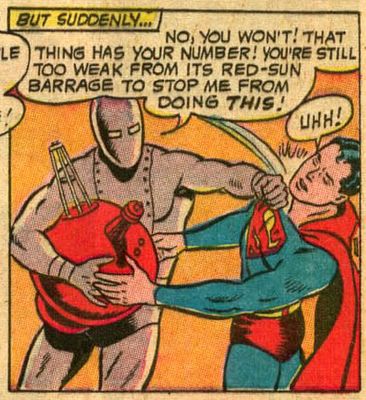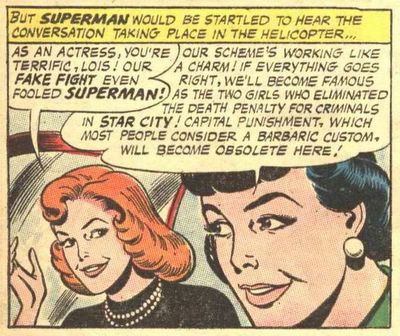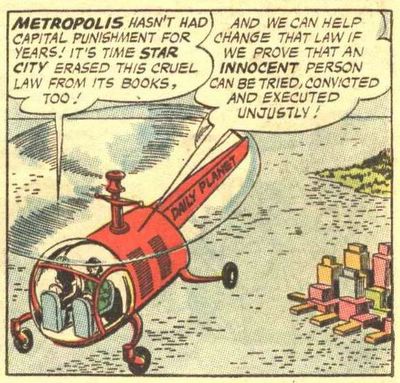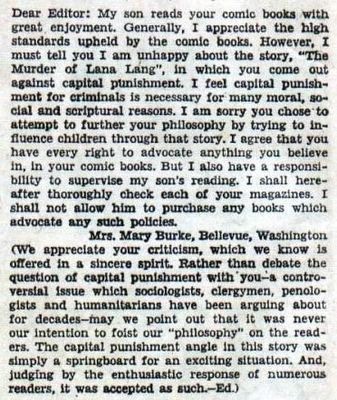Home » All posts
The Early Legion of Superheroes
Người đăng: vanmai yeu em on Thứ Hai, 6 tháng 6, 2005
The first appearance of the Legion was in Adventure #247, April 1958. Superboy is startled when several young people reveal that they know his secret identity. It turns out that they are superheroes from the future who have traveled back to Smallville to visit history's greatest hero.

They offer to induct him into their club, but insist that he pass a test first. The test is to defeat any of the three members of the Legion in a contest of heroic deeds. Unfortunately, every time Superboy gets ready to compete, his abilities are needed elsewhere, so he loses every contest. The Legion members regretfully inform him that he has been rejected. Despite being devastated, Superboy says, "No hard feelings", and turns to leave. Fortunately for him this was the last test. It turns out that the Legion members had caused the incidents requiring Superboy's attention to see if he would do his duty first before pursuing the honor of being inducted into the club. Very similar ending to #240, where Jor-El sends a robot to Earth to test Superboy's abilities. At the end of that story, the robot tells Superboy he has failed and must agree never to use his powers again. Superboy agrees at which point the robot reveals that was the final test. In this first story, there are only three named members of the Legion (Cosmic Boy, Saturn Girl, and Lightning Boy, whose name would later be changed to Lightning Lad), although Brainiac 5 obviously appears on pages 5 and 11 of the story.
In Adventure #267 the Legion returns. This time they interrupt Superboy's efforts to do good deeds and quickly turn Smallville against him. He leaves for space, but finds himself trapped by the Legion on a word devoted to Superboy's heroism. It turns out the Legion has seen pictures of the "future" which indicate he will go bad and destroy US military installations in five years. Interestingly, there is no real discussion of the propriety of "preventive detention". In the end, it turns out that the reason for the destruction was at the orders of the US President.
In Action #267, Saturn Girl, Lightning Lad and Cosmic Boy appear again, this time meeting Supergirl (whose very existence was unknown at the time). This is the first time they appear in the costumes that they will wear for the rest of the Silver Age. Saturn Girl had worn a green and yellow outfit in Adventure #247 and had brown hair in Adventure #267, while Cosmic Boy had a purple outfit in the latter issue instead of the pink duds he wore later. Oddly, the Legion members claim to be the children of the Legion members who had appeared in the earlier stories, although this notion quickly went by the wayside. In several places this story is a rehash of the Adventure #247 story, with Supergirl expressing delight and surprise at the exact same things that her cousin had a few years earlier.

This is the first official appearance for Legion members Colossal Boy, Chameleon Boy and Invisible Kid. Unfortunately for Supergirl, when she performs her initiation feat, she passes too close to a chunk of red Kryptonite, which turns her temporarily into an adult and thus makes her ineligible for the teen-aged Legion.
More about →

They offer to induct him into their club, but insist that he pass a test first. The test is to defeat any of the three members of the Legion in a contest of heroic deeds. Unfortunately, every time Superboy gets ready to compete, his abilities are needed elsewhere, so he loses every contest. The Legion members regretfully inform him that he has been rejected. Despite being devastated, Superboy says, "No hard feelings", and turns to leave. Fortunately for him this was the last test. It turns out that the Legion members had caused the incidents requiring Superboy's attention to see if he would do his duty first before pursuing the honor of being inducted into the club. Very similar ending to #240, where Jor-El sends a robot to Earth to test Superboy's abilities. At the end of that story, the robot tells Superboy he has failed and must agree never to use his powers again. Superboy agrees at which point the robot reveals that was the final test. In this first story, there are only three named members of the Legion (Cosmic Boy, Saturn Girl, and Lightning Boy, whose name would later be changed to Lightning Lad), although Brainiac 5 obviously appears on pages 5 and 11 of the story.
In Adventure #267 the Legion returns. This time they interrupt Superboy's efforts to do good deeds and quickly turn Smallville against him. He leaves for space, but finds himself trapped by the Legion on a word devoted to Superboy's heroism. It turns out the Legion has seen pictures of the "future" which indicate he will go bad and destroy US military installations in five years. Interestingly, there is no real discussion of the propriety of "preventive detention". In the end, it turns out that the reason for the destruction was at the orders of the US President.
In Action #267, Saturn Girl, Lightning Lad and Cosmic Boy appear again, this time meeting Supergirl (whose very existence was unknown at the time). This is the first time they appear in the costumes that they will wear for the rest of the Silver Age. Saturn Girl had worn a green and yellow outfit in Adventure #247 and had brown hair in Adventure #267, while Cosmic Boy had a purple outfit in the latter issue instead of the pink duds he wore later. Oddly, the Legion members claim to be the children of the Legion members who had appeared in the earlier stories, although this notion quickly went by the wayside. In several places this story is a rehash of the Adventure #247 story, with Supergirl expressing delight and surprise at the exact same things that her cousin had a few years earlier.

This is the first official appearance for Legion members Colossal Boy, Chameleon Boy and Invisible Kid. Unfortunately for Supergirl, when she performs her initiation feat, she passes too close to a chunk of red Kryptonite, which turns her temporarily into an adult and thus makes her ineligible for the teen-aged Legion.
Good Article on Ditko
Người đăng: vanmai yeu em on Chủ Nhật, 5 tháng 6, 2005
It's in Salon, so you have to put up with an ad to read the whole thing, but it's worth the effort.
Sixties hipsters thought that Ditko's urban realism and trippy visions meant that he was one of them. They couldn't have been much more wrong. Around the time that Ditko fell out with Marvel Comics in 1966, he became fascinated with Ayn Rand and objectivism, and his work started to take on a severe and increasingly strident right-wing tone.
Not sure how old Douglas Wolk is, but he's probably not remembering how left-wing everything seemed to be getting in America in the late-1960s. Ditko's comics were indeed a little strident, but they were a lone voice of sanity in a youth culture that was increasingly flirting with communism, moral relativism and nihilism. I have some scans of Ditko's work in this period including the terrific Blue Beetle issue that might as well be a primer for the works of Ayn Rand.
More about →
Sixties hipsters thought that Ditko's urban realism and trippy visions meant that he was one of them. They couldn't have been much more wrong. Around the time that Ditko fell out with Marvel Comics in 1966, he became fascinated with Ayn Rand and objectivism, and his work started to take on a severe and increasingly strident right-wing tone.
Not sure how old Douglas Wolk is, but he's probably not remembering how left-wing everything seemed to be getting in America in the late-1960s. Ditko's comics were indeed a little strident, but they were a lone voice of sanity in a youth culture that was increasingly flirting with communism, moral relativism and nihilism. I have some scans of Ditko's work in this period including the terrific Blue Beetle issue that might as well be a primer for the works of Ayn Rand.
Problems with the Silver Age Superboy
Người đăng: vanmai yeu em on Thứ Hai, 30 tháng 5, 2005
Originally there was no Superboy. Clark Kent's childhood was not discussed in any great detail in Action Comics #1, with only one panel showing the infant's strength to the amazed doctors in the orphanage.
But in More Fun Comics #101, (Jan/Feb 1945), DC decided to start telling the back story of Superman as a boy. After a brief run, the series shifted over to Adventure Comics, where it settled in for over 15 years as the cover feature. A few years after that, Superboy was given his own magazine as well, which lasted even longer.
It turned out (impossibly) that Superboy had been world famous himself. Impossibly, because of course in the early Superman stories he was a man of mystery whom nobody had ever seen before. Now we were being told that schoolchildren around the world knew his name. But this was only the beginning of the tangled knot.
Over the years, DC had developed many familiar situations for Superman. For example, he would often be faced with the problem of appearing as Superman and Clark Kent at the same time. In the late 1950s, obviously inspired by science fiction of the time, he invented robots that could take either of his places. Naturally there was a tendency to backdate this into the Superboy stories, regardless of whether it made sense, given the era in which the Superboy stories were supposedly occuring. If Superman's in 1955, then Superboy is in the early 1940s, certainly no later than 1945.
Similarly, DC "grandchilded" into the Superboy stories some of his later friends and enemies. Lex Luthor was a buddy of Superboy as a teen and only turned bitter when an experiment gone awry resulted in him losing all his hair. Master Mxyzptlk popped up in Superboy #78 (Jan 1960). Both these stories of course contradicted the original appearances of those villains in Superman stories.
More serious problems developed as a result of time travel. Time travel is always an interesting plot device and you will note that most of the DC heroes of the Silver Age had one method or another of traveling through time. Batman could be hypnotized by Professor Nichols, the Flash had his cosmic treadmill, the Atom his time pool, Superman could fly in circles, and for the rest of the DC crew there were the ubiquitous glass bubbles.
In Adventure #247, DC introduced the Legion of Superheroes, a future group of do-gooders who invited Superboy to join them. So far so good. But later on in Action #252, they decided to create Supergirl, a young cousin of Superman who survived the explosion of Krypton. Naturally she had to join the Legion of Superheroes as well. Which meant that in the future, Superboy and Supergirl would team up. But why then had Superman acted surprised when his cousin arrived; wouldn't he have known since his teen years that Supergirl would come to this planet? The editors quickly explained that Saturn Girl placed a post-hypnotic suggestion in Superboy's mind that resulted in him forgetting about Supergirl when he was in the past.
A further error was made in Adventure #253, when Robin comes back in time to save Superboy from a booby-trapped clock. He tells Superboy of his future, including his teamups with Batman. Again, these stories are wildly contradicted by earlier tales.
More about →
But in More Fun Comics #101, (Jan/Feb 1945), DC decided to start telling the back story of Superman as a boy. After a brief run, the series shifted over to Adventure Comics, where it settled in for over 15 years as the cover feature. A few years after that, Superboy was given his own magazine as well, which lasted even longer.
It turned out (impossibly) that Superboy had been world famous himself. Impossibly, because of course in the early Superman stories he was a man of mystery whom nobody had ever seen before. Now we were being told that schoolchildren around the world knew his name. But this was only the beginning of the tangled knot.
Over the years, DC had developed many familiar situations for Superman. For example, he would often be faced with the problem of appearing as Superman and Clark Kent at the same time. In the late 1950s, obviously inspired by science fiction of the time, he invented robots that could take either of his places. Naturally there was a tendency to backdate this into the Superboy stories, regardless of whether it made sense, given the era in which the Superboy stories were supposedly occuring. If Superman's in 1955, then Superboy is in the early 1940s, certainly no later than 1945.
Similarly, DC "grandchilded" into the Superboy stories some of his later friends and enemies. Lex Luthor was a buddy of Superboy as a teen and only turned bitter when an experiment gone awry resulted in him losing all his hair. Master Mxyzptlk popped up in Superboy #78 (Jan 1960). Both these stories of course contradicted the original appearances of those villains in Superman stories.
More serious problems developed as a result of time travel. Time travel is always an interesting plot device and you will note that most of the DC heroes of the Silver Age had one method or another of traveling through time. Batman could be hypnotized by Professor Nichols, the Flash had his cosmic treadmill, the Atom his time pool, Superman could fly in circles, and for the rest of the DC crew there were the ubiquitous glass bubbles.
In Adventure #247, DC introduced the Legion of Superheroes, a future group of do-gooders who invited Superboy to join them. So far so good. But later on in Action #252, they decided to create Supergirl, a young cousin of Superman who survived the explosion of Krypton. Naturally she had to join the Legion of Superheroes as well. Which meant that in the future, Superboy and Supergirl would team up. But why then had Superman acted surprised when his cousin arrived; wouldn't he have known since his teen years that Supergirl would come to this planet? The editors quickly explained that Saturn Girl placed a post-hypnotic suggestion in Superboy's mind that resulted in him forgetting about Supergirl when he was in the past.
A further error was made in Adventure #253, when Robin comes back in time to save Superboy from a booby-trapped clock. He tells Superboy of his future, including his teamups with Batman. Again, these stories are wildly contradicted by earlier tales.
Ferro Lad's Last Words
Người đăng: vanmai yeu em

One of the more famous deaths in the Silver Age. Ferro Lad was the creation of Jim Shooter, then a teenaged wunderkind comic writer. As a superhero, Ferro Lad wasn't much to speak of; he could turn his body into iron. This gave him great strength and near invulnerability, but that's about it. He sacrificed himself in order to transport a bomb to the heart of the Sun-Eater.
Liberal Media Bias at the Daily Planet?
Người đăng: vanmai yeu em on Thứ Tư, 18 tháng 5, 2005
In October 1963, DC Comics published Lois Lane #44, which exposed the Daily Planet for the liberal rag that it is. The story "The Death of Lana Lang" starts out with Lois and Lana battling it out for the affections of Superman. Lois threatens to kill Lana. However, they apparently patch things up and fly off in a helicopter, where they reveal their true plan:


So they pretend that Lois had killed Lana, who secretly hides out on Vulture Island while the trial is on-going, and plans to rescue her friend at the last minute by coming forward to prove she had not been killed after all. Lois is indeed sentenced to death. Of course, as is almost cliche in these stories, something goes wrong (Lana has a boating accident while returning from the island and is knocked unconscious), and it looks like Lois will actually be executed. Fortunately Superman saves the day (with a little help from mermaid Lori Lemaris), and at the end, Lois and Lana celebrate as the "barbaric custom" is banned in Star City.
However, DC did not get away with it scott-free. Check out this letter to the editor, which appeared a few issues later:

I agree to a certain extent with both the editor and Mrs Burke on this one. I do think Lois' opposition to the death penalty was largely just a plot device to create an interesting story. However the bit about "most people" considering capital punishment a "barbaric custom" does seem a bit over the top.
More about →


So they pretend that Lois had killed Lana, who secretly hides out on Vulture Island while the trial is on-going, and plans to rescue her friend at the last minute by coming forward to prove she had not been killed after all. Lois is indeed sentenced to death. Of course, as is almost cliche in these stories, something goes wrong (Lana has a boating accident while returning from the island and is knocked unconscious), and it looks like Lois will actually be executed. Fortunately Superman saves the day (with a little help from mermaid Lori Lemaris), and at the end, Lois and Lana celebrate as the "barbaric custom" is banned in Star City.
However, DC did not get away with it scott-free. Check out this letter to the editor, which appeared a few issues later:

I agree to a certain extent with both the editor and Mrs Burke on this one. I do think Lois' opposition to the death penalty was largely just a plot device to create an interesting story. However the bit about "most people" considering capital punishment a "barbaric custom" does seem a bit over the top.










